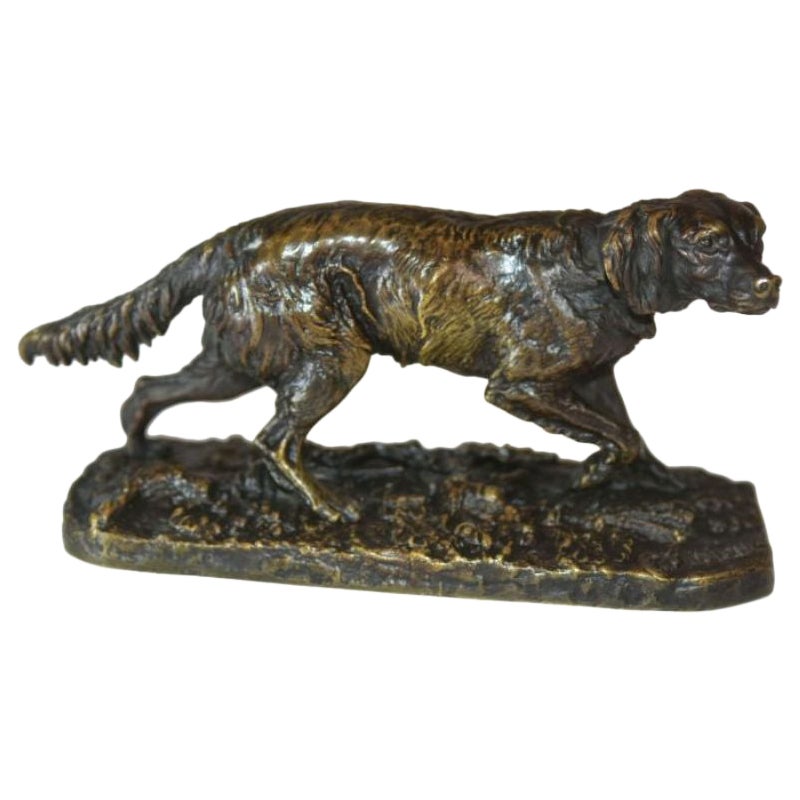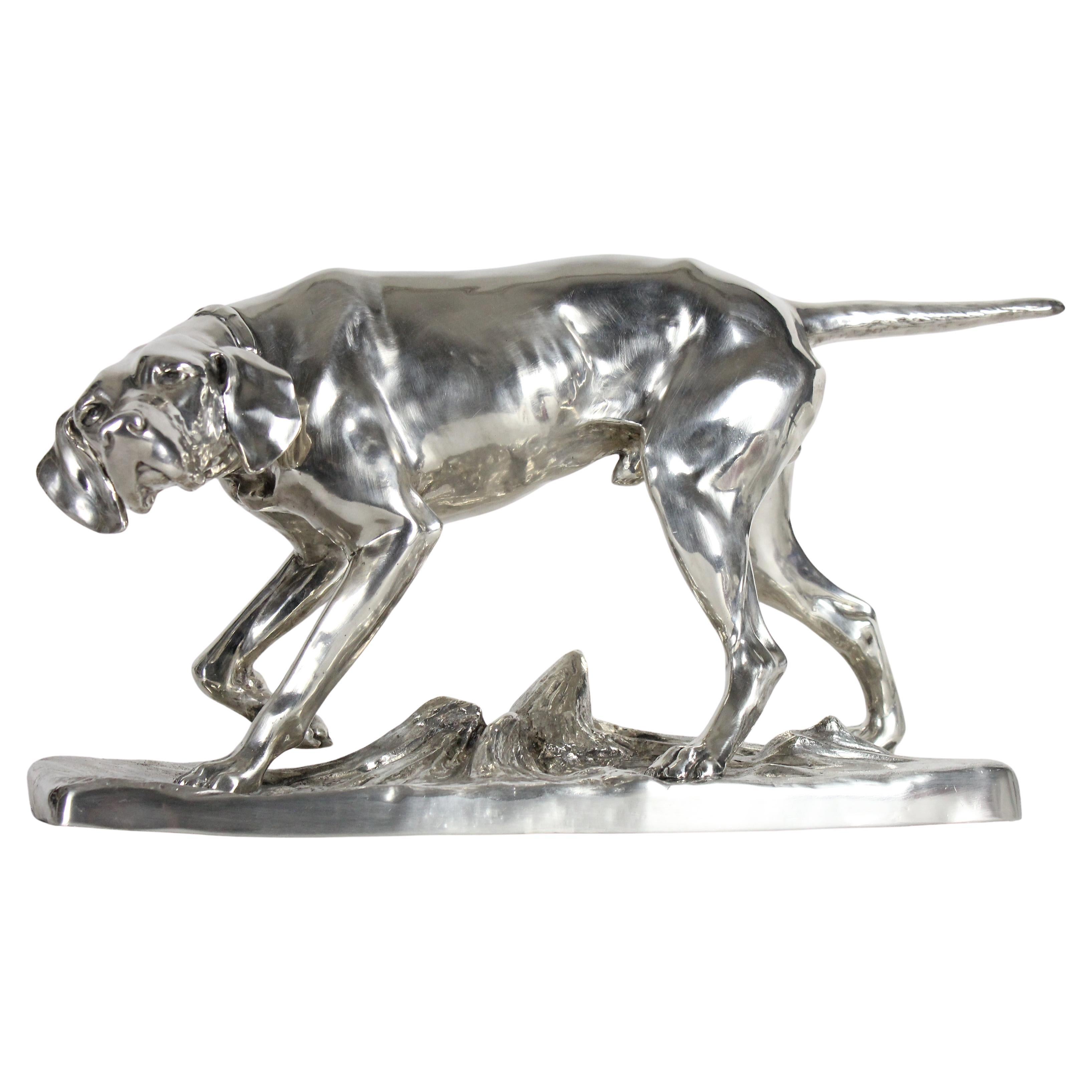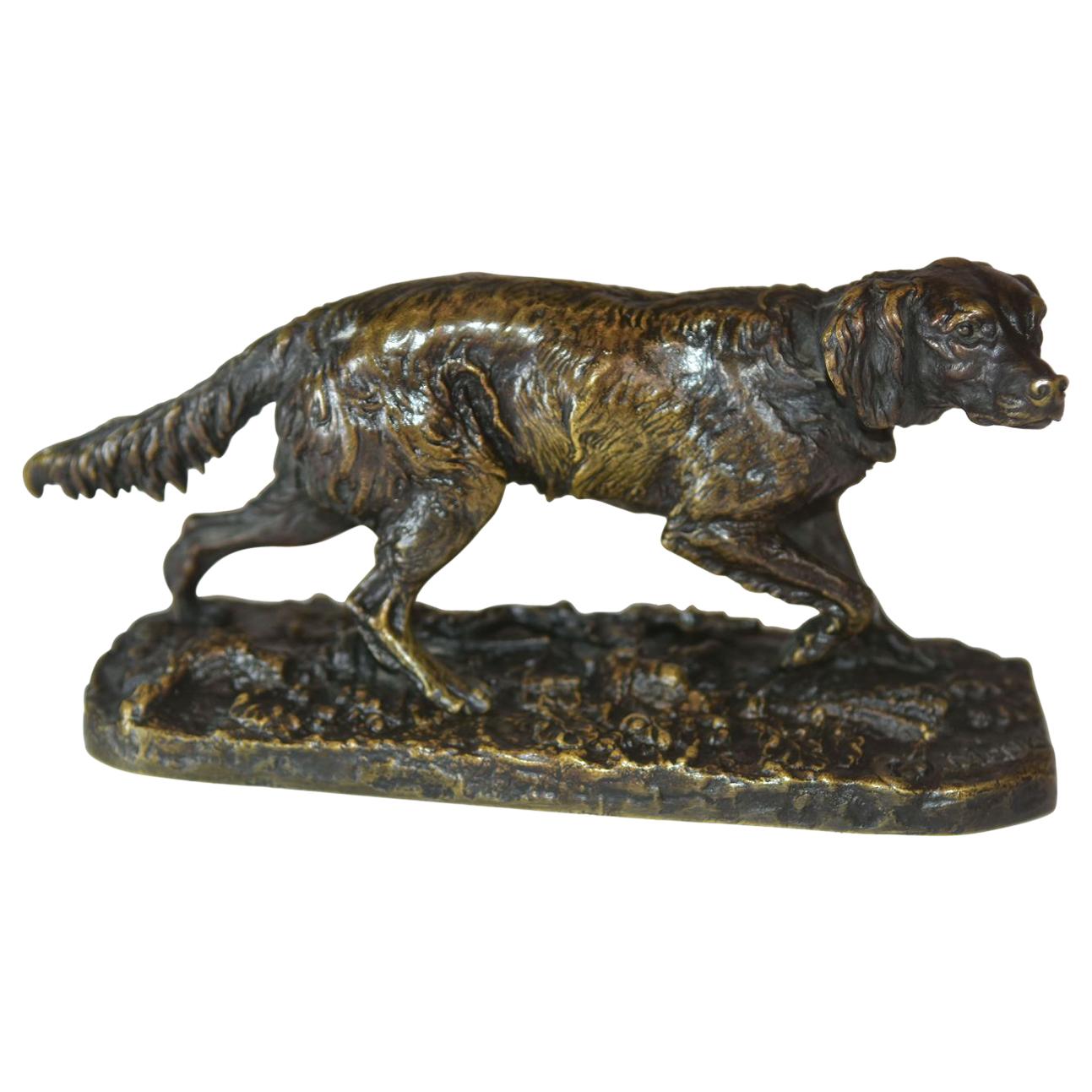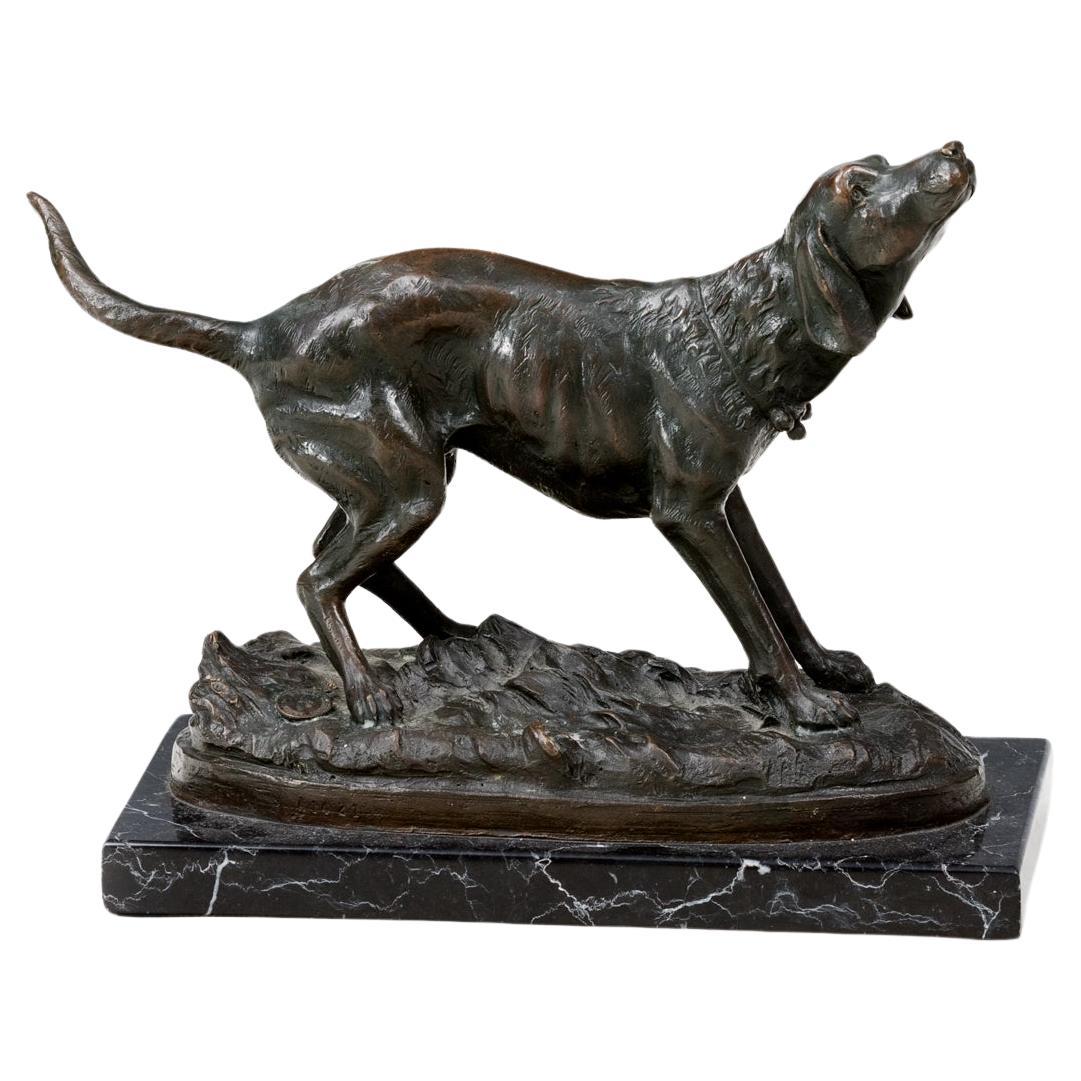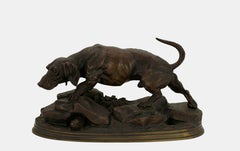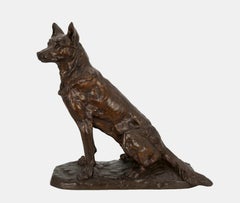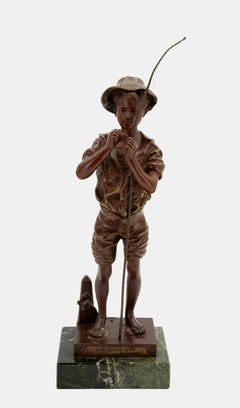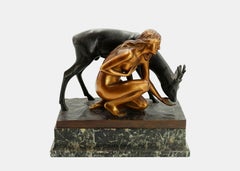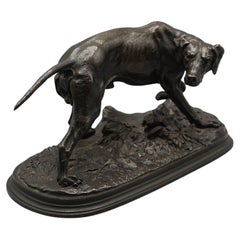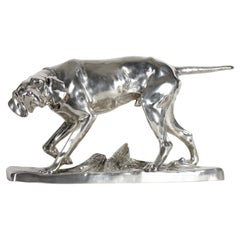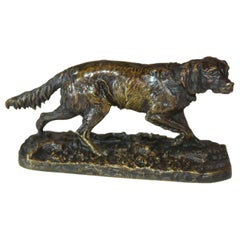Items Similar to Pointer / - The elegance of the hunting dog -
Want more images or videos?
Request additional images or videos from the seller
1 of 7
Anton BüschelbergerPointer / - The elegance of the hunting dog -c. 1930
c. 1930
$548.26
$685.3320% Off
£417.24
£521.5520% Off
€464
€58020% Off
CA$767.48
CA$959.3520% Off
A$845.70
A$1,057.1320% Off
CHF 438.65
CHF 548.3220% Off
MX$10,058.50
MX$12,573.1320% Off
NOK 5,548.83
NOK 6,936.0320% Off
SEK 5,198.07
SEK 6,497.5920% Off
DKK 3,534.69
DKK 4,418.3620% Off
About the Item
Anton Büschelberger (1869 Eger - 1934 Dresden), Pointer, around 1930, made by the Karl Ens porcelain manufactory in Volkstedt (Thuringia), model number 2478, 6. Porcelain with underglaze decoration and terrain plinth. 17 cm (height) x 37 cm (length) x 11 cm (depth). Signed “A. Büschelberger” on the plinth, marked under the base and with the model number.
- Plinth and right hind leg with cracks, probably caused by firing, base and underside of the flanks with glaze damage.
- The elegance of the hunting dog -
With his head slightly bent forward and his tail stretched out, the hound is on the prowl with his front leg slightly raised. He has followed the scent and already has his prey in sight. Anton Büschelberger captures the moment just before the drama of the hunt unfolds, showing the dog in a state of intense, instinctive tension. Every muscle seems to be visible under the fur, giving the animal a special elegance. The coloration, which matches the true-to-life effect of its appearance, was created using an early airbrush technique that produces delicate color gradients that match the shimmer of the porcelain.
GERMAN VERSION
Anton Büschelberger (1869 Eger - 1934 Dresden), Vorstehhund, um 1930. Ausführung der Porzellanmanufaktur Karl Ens in Volkstedt (Thüringen), Modellnummer 2478, 6. Porzellan mit Unterglasurstaffage und Terrainplinthe. 17 cm (Höhe) x 37 cm (Länge) x 11 cm (Tiefe). Auf der Plinthe mit „A. Büschelberger“ signiert, unter dem Boden gemarkt und mit der Modellnummer versehen.
- Plinthe und rechter Hinterlauf mit wohl brandbedingten Rissen, Sockel und Unterseite der Flanken mit Glasurschäden.
- Die Eleganz des Jagdhundes -
Mit leicht geducktem, nach vorne gerecktem Kopf und ausgestrecktem Schwanz ist der Jagdhund auf der auf der Pirsch und hat den Vorderlauf leicht angehoben. Er ist der Witterung gefolgt und hat die Beute bereits im Blick. Anton Büschelberger zeigt eben jenem Moment, kurz bevor sich das jagdliche Drama abspielt und veranschaulicht den Hund in höchster instinktgeleiteter Anspannung. Jeder Muskel scheint sich unter dem Fell abzuzeichnen, was dem Tier eine besondere Eleganz verleiht. Die zur lebensnahen Wirkung seiner Erscheinung passende Farbigkeit ist mit einer frühen Airbrushtechnik erfolgt, die zarte zum Schimmer des Porzellans passende Farbverläufe erzeugt.
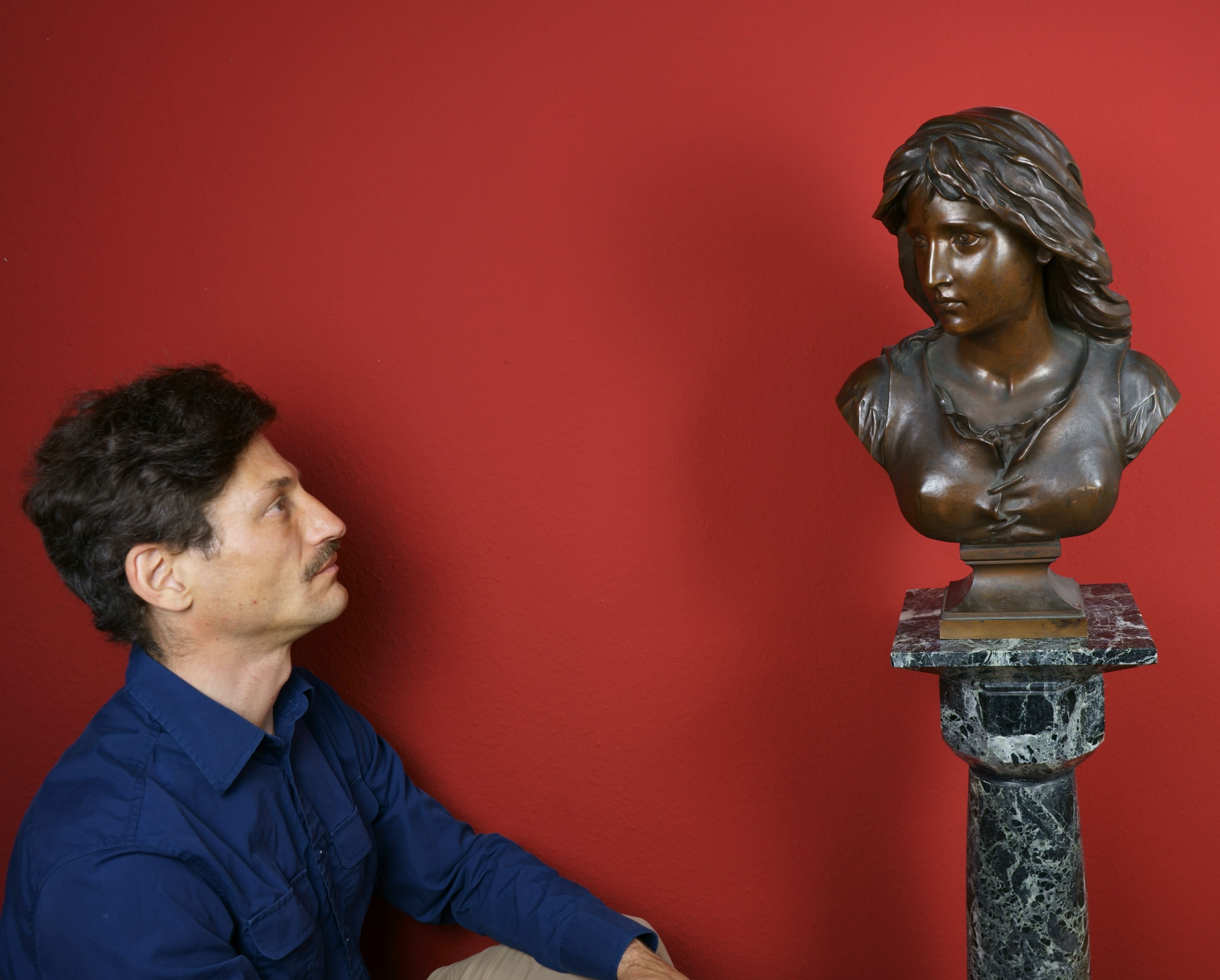
About the Seller
5.0
Vetted Professional Seller
Every seller passes strict standards for authenticity and reliability
Established in 2014
1stDibs seller since 2023
22 sales on 1stDibs
- ShippingRetrieving quote...Shipping from: Berlin, Germany
- Return Policy
More From This Seller
View AllHunting dog on the prowl / - Following the scent -
By Jules Moigniez
Located in Berlin, DE
Jules Moigniez (1835 Senlis - 1894 St-Martin-du-Tertre), Hunting dog on the prowl, around 1880. Dark patinated bronze with naturalistic terrain plinth, 16 cm (height) x 30 cm (length...
Category
1890s Naturalistic Figurative Sculptures
Materials
Bronze
Vigilant Sitting German Shepherd / - The Epitome of the German Shepherd -
Located in Berlin, DE
Albert Pierre LaPlanche (1854 Sainte-Menehould - 1935 Chäteau-Thierry), Vigilant sitting shepherd dog, around 1915. Brown patinated bronze on cast terrain plinth. 45 cm (height) x 45...
Category
1910s Realist Figurative Sculptures
Materials
Bronze
Pecheur / - Full of anticipation -
Located in Berlin, DE
Adolphe Jean Lavergne (1863-1928), Pecheur, c. 1900. Brown patinated bronze with rectangular cast plinth on a green marble base (3 cm high), total height with hinge 37 cm, width 9 cm, depth 8 cm, weight 2.9 kg, signed “Lavergne” on the plinth.
- Base with old drilling and a few oxidized areas, patina occasionally rubbed, somewhat stained in the folds.
- Full of anticipation -
This bronze is the larger, highly detailed version of the fisherman that made Parisian artist Adolphe Jean Lavergne famous. In preparation for fishing, the boy prepares his rod before heading out to sea. The attachment of the iron ring and the rope behind him suggest a quay wall and a boat moored there. However, the depiction is entirely focused on the actual action of the young fisherman: With equal skill and concentration, he bends a hook to connect it to the fishing line. The contrast with his casual clothing, the loose-fitting trousers, the open shirt with its "wild" folds, and, last but not least, the sun hat boldly perched on his neck, reinforces the impression of the attentive care with which he goes about his work. His gaze makes him appear absorbed, as if he has forgotten the world around him and yet he is visibly filled with anticipation of fishing.
GERMAN VERSION
Adolphe Jean Lavergne (1863-1928), Pecheur, um 1890. Braun patinierte Bronze mit rechteckiger gegossener Plinthe auf grünem Marmorsockel (3 cm Höhe), Gesamthöhe mit Angel 37 cm, Breite 9 cm, Tiefe 8 cm, Gewicht 2,9 kg, auf der Plinthe mit „Lavergne“ signiert.
- Sockel mit alter Bohrung und wenigen oxidierten Stellen, Patina mitunter berieben, in den Falten vereinzelt etwas fleckig.
- Voller Vorfreude -
Die Bronzefigur ist die größere äußerst detaillierte Ausführung des Fischers, mit dem der Pariser Künstler Adolphe Jean Lavergne bekannt geworden ist. In Vorbereitung auf das Fischen präpariert der Junge die Angel...
Category
1890s Realist Figurative Sculptures
Materials
Bronze
$680 Sale Price
20% Off
The Feeding / - Natural grace -
Located in Berlin, DE
Erich Schmidt-Kestner (1877 Berlin - 1941 Nordhausen), The Feeding, around 1915. Gold and black patinated bronze with cast brown patinated plinth mounted on a lightly veined black-gr...
Category
1910s Art Nouveau Nude Sculptures
Materials
Bronze
$4,253 Sale Price
20% Off
Forest idyll / - Soulmate -
By Rudolf Kaesbach
Located in Berlin, DE
Rudolf Kaesbach (1873 Gladbach - 1955 Berlin), Forest idyll, around 1915. Bronze, gold and golden brown patina, with cast plinth, mounted on a marble base (5 cm high), total height 36 cm, dimensions of the bronze: 31 cm (height) x 17 cm (length) x 12 cm (width). Weight 4,6 kg, signed on the plinth "R.[udolf] KAESBACH".
- a few rubbed areas, overall in excellent condition for its age
- Soulmate -
The bronze sculpture depicts a young woman in an intimate exchange with a deer that accompanies her. The animal pauses to turn toward her, while the nude beauty slows her pace to look into the deer's eyes and tenderly caress it with her hand. The woman and the deer are in inner harmony. Even though her lips remain motionless, she speaks the language of the animal with which she is deeply connected.
The golden patina, which contrasts with the more naturalistic coloring of the deer, gives the young woman the appearance of a saint, even if she cannot be identified as such. At the same time, she evokes memories of Diana, the goddess of the hunt, or a nymph. But she lacks the ferocity. In her innocent naivety, she is more like a vestal virgin, who is not at home in the solitude of the forest. And yet, the young beauty, moving unclothed in the heart of nature, looks like a priestess with her hair tied up and a carefully carried bowl on her way to a sacred grove.
In order to open up the above-mentioned associations, Kaesbach deliberately designed the female figure in such a way that she cannot be identified as a specific person. He has created an allegory of natural femininity, characteristic of Art Nouveau, in which the deer is far more than a companion animal. It displays the same gracefulness as the young woman, and the inner resemblance between the two makes the deer appear as her other self. In animal terms, it embodies her inner being, which also gives the deer an allegorical character.
About the artist
Rudolf Kaesbach studied sculpture at the Hanau Academy and worked in a bronze foundry in Paris in 1900. In order to work as an independent artist, he opened a workshop in Düsseldorf, where he cast bronzes from models he designed. In 1902 he made his debut at the German National Art Exhibition in Düsseldorf. The following year Kaesbach went to the academy in Brussels. There he was inspired by contemporary Belgian sculpture, especially the work of Constantin Meunier. He moved to Berlin, where he opened a studio in the villa district of Grunewald and devoted himself to life-size marble sculptures and the design of bronzes. From 1911, he regularly presented his works at the major art exhibitions in Berlin, as well as in Düsseldorf and Malmö. Between 1936 and 1939, he also created models for the Rosenthal porcelain factory. From 1939 to 1944, Kaesbach was represented at the major German art exhibitions in Munich.
GERMAN VERSION
Rudolf Kaesbach (1873 Gladbach - 1955 Berlin), Waldidyll, um 1915. Gold und goldbraun patinierte Bronze mit gegossener Plinthe, auf einem Marmorsockel montiert (5 cm Höhe), Gesamthöhe 36 cm, Maße der Bronze: 31 cm (Höhe) x 17 cm (Länge) x 12 cm (Breite). Gewicht 4,6 kg, auf der Plinthe mit „R.[udolf] KAESBACH“ signiert.
- vereinzele beriebene Stellen, insgesamt in einem altersgemäß ausgezeichneten Zustand
- Seelenverwandtschaft -
Die Bronzeplastik veranschaulicht eine junge Frau im innigen Austausch mit einem sie begleitenden Reh. Das Tier hält inne, um sich zu ihr hochzuwenden, während die nackte Schönheit ihren Schritt verlangsamt, um dem Reh ebenfalls in die Augen zu schauen und es zärtlich mit der Hand zu liebkosen. Die Frau und das Reh sind in einem inneren Gleichklang. Auch wenn ihre Lippen unbewegt bleiben, spricht sie die Sprache des Tieres, mit dem sie auf eine tief empfundene Weise verbunden ist.
Die im Kontrast zur naturalistischeren Einfärbung des Rehs aufstrahlende goldfarbene Patina lässt die junge Frau wie eine Heilige erscheinen, auch wenn sich nicht als Heilige identifizierbar ist. Zugleich ruft sie Erinnerungen an die Jagdgöttin Diana oder eine Nymphe hervor. Dafür fehlt ihr allerdings die Wildheit. In ihrer unschuldigen Naivität gemahnt sie vielmehr an eine Vestalin, die freilich nicht in der Waldeinsamkeit zu Hause ist. Und doch wirkt die sich unbekleidet im Herzen der Natur bewegende junge Schönheit wie eine Priesterin, die sich mit hochgebundenem Haar und der vorsichtig getragenen Schale und dem Wege zu einem Heiligen Hain befindet.
Um die gennannten Assoziationen zu eröffnen, hat Kaesbach die Frauenfigur bewusst so gestaltet, dass sie nicht als konkrete Person identifizierbar ist. Damit hat er eine für den Jugendstil charakteristische Allegorie natürlicher Weiblichkeit geschaffen, bei der das Reh weit mehr als ein Begleittier ist. Es weist dieselbe grazile Anmut wie die junge Frau auf und der innere Gleichklag der beiden lässt das Reh als ihr anderen Ich erscheinen. Es verkörpert – ins Animalische übertragen - ihr inneres Wesen, wodurch auch dem Reh ein allegorischer Charakter zukommt.
zum Künstler
Rudolf Kaesbach studierte an der Akademie Hanau Bildhauerei und war im Jahr 1900 in einer Pariser Bronzegießerei tätig. Um sich als eigenständiger Künstler betätigen zu können, eröffnete er in Düsseldorf eine Werkstatt, in der er Bronzen nach selbstentworfenen Modellen goss. 1902 debütierte er auf der Deutschen Nationalen Kunstaustellung in Düsseldorf. Im Folgejahr ging Kaesbach an die Akademie nach Brüssel. Dort wurde er von der zeitgenössischen belgischen Bildhauerei, insbesondere vom Werk Constantin Meuniers, inspiriert. Zurückgekehrt zog er nach Berlin, wo er im Villenviertel Grunewald ein Atelier eröffnete und sich neben dem Entwurf für Bronzen der lebensgroßen Marmorbildhauerei widmete. Ab 1911 präsentierte er seine Werke regelmäßig auf den Großen Berliner Kunstausstellungen, aber auch in Düsseldorf und Malmö. Zwischen 1936 und 1939 fertigte er zudem Modelle für die Porzellan-Manufaktur Rosenthal an. Von 1939 bis 1944 war...
Category
1910s Jugendstil Nude Sculptures
Materials
Bronze
$3,970 Sale Price
20% Off
Spear Fighter / - The Fighter's Concentration -
Located in Berlin, DE
Ludwig Eisenberger (active in Berlin between 1895-1920), Spear Fighter, around 1910. Brown patinated bronze with residual gilding on a cast terrain plinth with marble base (8 cm high...
Category
1910s Realist Nude Sculptures
Materials
Bronze
$3,592 Sale Price
20% Off
You May Also Like
'Pointer' by Pierre Jules Mêne
By Pierre Jules Mêne
Located in Forest Row, East Sussex
A late Victorian Bronze Pointer by Pierre Jules Mene (1810-1879). Excellent patination, signed 'P.J. Mene' to base.
Dimensions: H 11cm W 22cm D 9.5cm
Origin: French
Date: Circa...
Category
Antique 1860s French Animal Sculptures
Materials
Bronze
Hunting Dog by Pj Mêne Probably a 19th Century Spaniel
Located in Marseille, FR
Hunting dog by Pierre-Jules Mêne (1810-1879) probably a space spaniel dimensions length 19 cm or 2 cm high and 8 cm deep late 19th century.
Additional information:
Material: bron...
Category
Antique Late 19th Century Animal Sculptures
Materials
Bronze
Pointer Dog, Sculpture by Wilhelm Zwick for Kayser, Germany 1920s.
By Kayser Germany, Wilhelm Zwick
Located in Skanninge, SE
Amazing sculpture depicting a Pointer dog.
Designed by German artist Wilhelm Zwick and executed by the German firm Kayserzinn.
The condition of this sculpture is really good. Only a ...
Category
Vintage 1920s German Animal Sculptures
Materials
Metal
19th Century Hunting Dog by P.J Probably Leads Spaniel
By Pierre Jules Mêne
Located in Marseille, FR
19th century hunting dog by Pierre-Jules Mêne (1810-1879) probably a spaniel space.
Category
Antique 19th Century French Animal Sculptures
Materials
Bronze
20th Century Bronze Sculpture of a Hunting Dog
By Miguel Fernando Lopez 1
Located in Dublin 8, IE
20th Century Bronze Sculpture of a Hunting Dog by the artist Miguel Fernando López (Milo). Depicting an alert dog on a naturalistic base signed 'Milo'. Raised on a black marble plinth.
Category
20th Century Portuguese Animal Sculptures
Materials
Bronze
Alfred Dubucand (1828-1894): Two hunting dogs
Located in Berlin, DE
Dubucand Alfred 1828-1894
Two Hunting Dogs, Bronze on a Marble Base
The Bronze with the monogram 'E.V.' and the number '2958'
Two Hunting Dogs, Group Signed Alfred Dubucand, Fren...
Category
Late 19th Century Realist Figurative Sculptures
Materials
Bronze


